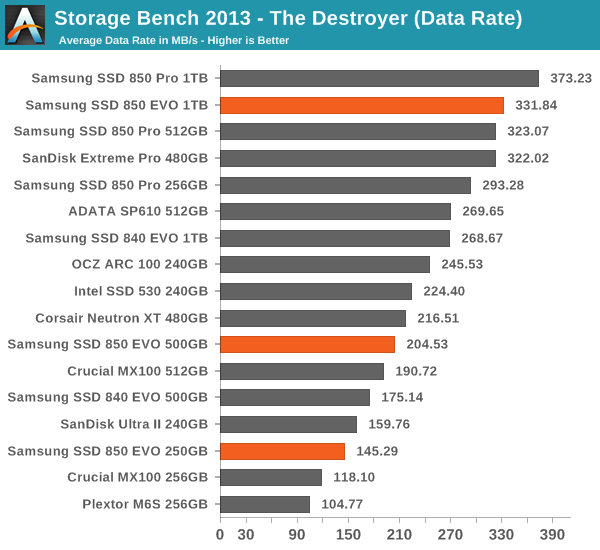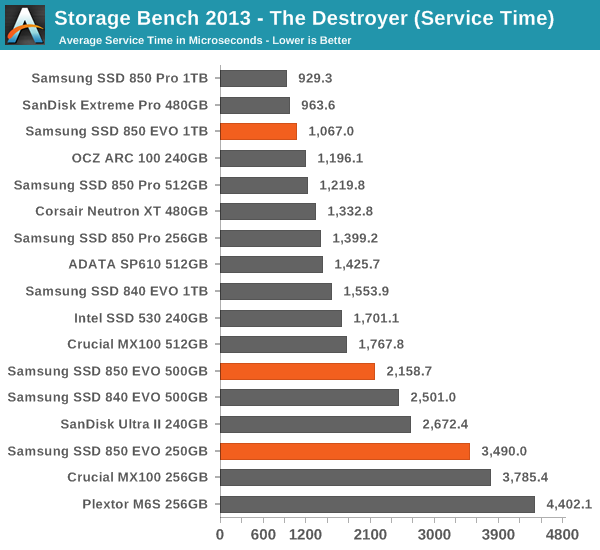Samsung SSD 850 EVO (120GB, 250GB, 500GB & 1TB) Review
by Kristian Vättö on December 8, 2014 10:00 AM ESTAnandTech Storage Bench 2013
Our Storage Bench 2013 focuses on worst-case multitasking and IO consistency. Similar to our earlier Storage Benches, the test is still application trace based – we record all IO requests made to a test system and play them back on the drive we are testing and run statistical analysis on the drive's responses. There are 49.8 million IO operations in total with 1583.0GB of reads and 875.6GB of writes. I'm not including the full description of the test for better readability, so make sure to read our Storage Bench 2013 introduction for the full details.
| AnandTech Storage Bench 2013 - The Destroyer | ||
| Workload | Description | Applications Used |
| Photo Sync/Editing | Import images, edit, export | Adobe Photoshop CS6, Adobe Lightroom 4, Dropbox |
| Gaming | Download/install games, play games | Steam, Deus Ex, Skyrim, Starcraft 2, BioShock Infinite |
| Virtualization | Run/manage VM, use general apps inside VM | VirtualBox |
| General Productivity | Browse the web, manage local email, copy files, encrypt/decrypt files, backup system, download content, virus/malware scan | Chrome, IE10, Outlook, Windows 8, AxCrypt, uTorrent, AdAware |
| Video Playback | Copy and watch movies | Windows 8 |
| Application Development | Compile projects, check out code, download code samples | Visual Studio 2012 |
We are reporting two primary metrics with the Destroyer: average data rate in MB/s and average service time in microseconds. The former gives you an idea of the throughput of the drive during the time that it was running the test workload. This can be a very good indication of overall performance. What average data rate doesn't do a good job of is taking into account response time of very bursty (read: high queue depth) IO. By reporting average service time we heavily weigh latency for queued IOs. You'll note that this is a metric we have been reporting in our enterprise benchmarks for a while now. With the client tests maturing, the time was right for a little convergence.

The faster NAND and better IO consistency results in increased performance in our 2013 Storage Bench. The 1TB version shines in the test and isn't far from the 850 Pro, but the 500GB and 250GB models end up being middle-class performers. Especially the performance of the 250GB model is a bit underwhelming because it is beaten by the Ultra II, even though the 850 EVO should have a performance advantage thanks to V-NAND.











97 Comments
View All Comments
KAlmquist - Monday, December 8, 2014 - link
My guess is that Samsung doesn't have the ability to produce very much V-NAND. So the 850 PRO, and now the 850 EVO, are priced to encourage most people to choose SSD's from the 840 line rather than the 850 line, preventing demand for the 850 line from exceeding the supply.rms141 - Monday, December 8, 2014 - link
The absence of the Samsung 840 Pro from the Storage Bench 2013 section is pretty odd. Why wouldn't you include the previous generation's higher performing product? This is a little bit like publishing a GTX 970 review without including the GTX 780 for reference.Kristian Vättö - Tuesday, December 9, 2014 - link
You can always use the Bench tool to compare any and all drives that we have tested over the years:http://www.anandtech.com/bench/SSD/65
fokka - Monday, December 8, 2014 - link
it doesn't make much sense to complain about the msrp when the drive is just now trickling to retailers. you're probably not gonna make a good deal on a 850 evo before christmas, but the prices will come down considerably in q1/q2 2015, they always do.that said, i wouldn't mind paying a couple bucks more for a 850, compared to a 840, since it's just the all around better drive and it's lower power consumption alone makes it the better option for laptops.
pitted against an mx100 it might be a tougher sell, but let's just wait a bit for the prices to come down and give the early adopters some time to beta-test the firmware for us in the meantime.
Morawka - Tuesday, December 9, 2014 - link
Does TurboWrite, native encryption, and TRIM work in RAID 0 on the 850 EVO? Thats the only way i would invest $500+ into a SSD still bottlenecked by Sata 6hojnikb - Tuesday, December 9, 2014 - link
All of that should work with appropriate motherboard/storage drives, because drive itself is not aware whenever is in RAID or not.hojnikb - Tuesday, December 9, 2014 - link
*driverspaesan - Tuesday, December 9, 2014 - link
I just got a 1TB 840 evo for $369. No way the 850 evo is worth the extra $100.R3MF - Tuesday, December 9, 2014 - link
How do you conduct this review of a perfomance oriented SSD without discussing:1. m.2 format (or lack thereof)?
2. PCIe 3.0 4x m.2 performance (vs SATA 6G)?
3. NVME m.2 performance (vs SATA 6G)?
It is the end of 2014, who seriously spends £320 on a 1TB performance SSD without considering the high-speed m.2 drives just around the corner, to which a growing number of enthusiasts have empty slots on their shiny new motherboards?
hojnikb - Tuesday, December 9, 2014 - link
>How do you conduct this review of a perfomance oriented SSD without discussing:EVO is not a performance oriented drive. 850PRO is. And this was already discussed in other reviews/seperate articles.